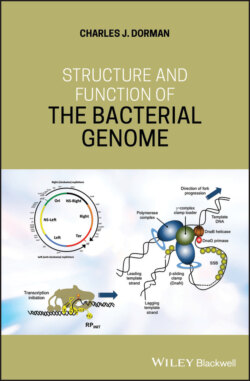Читать книгу Structure and Function of the Bacterial Genome - Charles J. Dorman - Страница 16
1.5 Chromosome Replication: Termination
ОглавлениеTermination of DNA synthesis occurs within Ter, located at a point that is diametrically opposite oriC on the chromosome (Hill et al. 1987) (Figure 1.7). The Ter region has five copies of a 23‐bp DNA element on each flank and the 36‐kDa Tus protein binds to these sequences (Neylon et al. 2005). The Tus binding sites are asymmetric and have a permissive and a non‐permissive orientation (Figure 1.7). Replication forks can pass the Tus‐Ter nucleoprotein complexes when the DNA sequences are in the permissive orientation, but fork movement becomes arrested when the sequences are oriented in the non‐permissive direction. The mechanism of replication fork passage at Ter sites that are in the permissive orientation involves displacement of Tus by the DnaB helicase; when in the non‐permissive orientation, Tus prevents DnaB, and the replication fork, from translocating past that point (Bastia et al. 2008; Berghuis et al. 2015; Mulcair et al. 2006). Single‐molecule experiments performed in vitro have shown that the DNA also plays a critical role: in the non‐permissive orientation, the unwinding of the DNA by the approaching replication fork creates a powerful lock at the Tus‐Ter site that is an effective roadblock to further translocation by the fork; in the permissive orientation the lock does not operate and the fork can proceed (Berghuis et al. 2015).
Figure 1.7 Termination of chromosome replication in E. coli. (a) The moving replisome encounters an appropriately oriented Tus/Ter nucleoprotein complex and the interaction between Tus and the DnaB helicase halts replisome movement, leading to the termination of chromosome replication. (b) The 4.6 Mb chromosome of E. coli is shown, indicating the relative positions and orientations of the Ter sequences (grey arrowheads) with respect to one another and oriC and the tus gene. The black arrows on either side of oriC indicate the bidirectional nature of E. coli chromosome replication. Ter sites aligned with the direction of replication are in the permissive orientation and will allow the replication fork to pass; those oriented against the direction of fork movement are in the non‐permissive configuration and will halt fork movement if bound by Tus. The promoter of the tus gene overlaps the TerB sequence, resulting in negative autoregulation of tus transcription by the Tus protein. (c) An alignment of the DNA sequences of the Ter elements, showing the high degree of sequence conservation among the sites and the lack of dyad symmetry within each site. The latter feature ensures that the sites operate to stop forks moving in one direction only.
The newly synthesised DNA strand is unmethylated and forms one part of a hemimethylated duplex. For this reason, the products of chromosome replication are chemically distinct from the template duplex until a full methylation of the newly synthesised strand has taken place. DNA adenine methyltransferase, Dam, methylates DNA at 5′‐GATC‐3′ sites and there are 11 of these sites in oriC (Figure 1.2). The SeqA protein binds to these sites while they are still in their hemimethylated form, sequestering the origin and excluding DnaA (Han et al. 2003; Slater et al. 1995; von Freiesleben et al. 1994). The sequestered state persists for about one third of the cell cycle when it is relieved by dissociation of SeqA and methylation of the 5′‐GATC‐3′ sites by Dam (Kang, S. et al. 1999; Lu et al. 1994). SeqA also interferes with expression of the dnaA gene, reducing the levels of the DnaA protein available for binding to oriC (Campbell and Kleckner 1990). In addition, SeqA contributes to processes that ensure proper segregation of the chromosome copies at cell division (Helgesen et al. 2015; Waldminghaus and Skarstad 2009). It is interesting to note that both hemimethylated oriC and SeqA have been shown to associate with the cell envelope (Ogden et al. 1988; Slater et al. 1995), perhaps indicating a role for the complex in the positioning of oriC in the cell.
